Spike Lee is an Academy Award-winning filmmaker best known for his films, Do the Right Thing and She’s Gotta Have It. Voted the 48th Best Director of All Time by Entertainment Weekly, Spike Lee is a revered name in the film industry.
The Spike Lee MasterClass is a chance to learn independent filmmaking from one of the most prolific directors in America.
If you’re reading this Spike Lee MasterClass Review, you’re likely keen to see whether this course is a good one to commit to.
Before I carry on, here’s a quick summary of my key points:
.
Quick Summary
Learn how to:
- Find and develop compelling film ideas
- Tell a story through cinema
- Collaborate with your cast and crew
- Create storyboards as a blueprint for your movie
- Use films as an agent of change
Pros
- Learn from a renowned filmmaker
- Strong case studies and examples
- Easy-to-follow teaching
Cons
- Not a course for beginners
- Focus on socio-political filmmaking
- Less theory-based than other courses
Course length: 19 lessons, 3hr 12m.
Best for: Film students or graduates looking to get into independent filmmaking.
Overall: An insightful class that looks at the practicalities of directing, financing, and editing a film. This MasterClass focuses on using film as an agent of change and the realities of working towards an end-product (view details).
I’ll now look further into what this MasterClass includes, what I loved and learned and where it fell a little short.
Here’s what I’ll cover:
- About Spike Lee and MasterClass
- Inside Spike Lee’s MasterClass
- What I liked and felt could be improved
- Who this course is for, prices, and alternatives
- What others have said about the class
- Verdict – is the Spike Lee MasterClass worth it?
But first a few basics…
About Spike Lee
Spike Lee had his directorial debut in 1986 with the film, She’s Gotta Have It.
Working as a director, writer, producer, and actor, he became well-established as an independent filmmaker in New York.
He earned the Time Warner Innovator Award at the American Black Film Festival in 2004.
If you’re keen to learn how to take your ideas from page to screen, this MasterClass is unrivalled viewing.
And if you haven't seen the trailer, it's a must watch:
About MasterClass
“Learn without limits.”
Founded in 2015, MasterClass is an online educational resource dedicated to ensuring you learn from the best. With 80+ video classes from acclaimed celebrities, MasterClass has surged to the top of the list when it comes to online learning.
Among MasterClass’s teaching panel are Anna Wintour, Gordon Ramsay, and even Tony Hawk. Their courses are matched with impressive production values and additional resources to help you learn.
You can purchase a single course for $90 or opt for an all-access pass, which enables you access to unlimited courses within a yearly subscription.
MasterClass has indisputably changed the landscape of online learning. As a relatively new company, I’m intrigued to see where this platform will take us.
At the same time, MasterClass might not be for everyone. I hope to give a well-rounded review of this course to help you decide whether MasterClass is for you.
Inside Spike Lee’s MasterClass
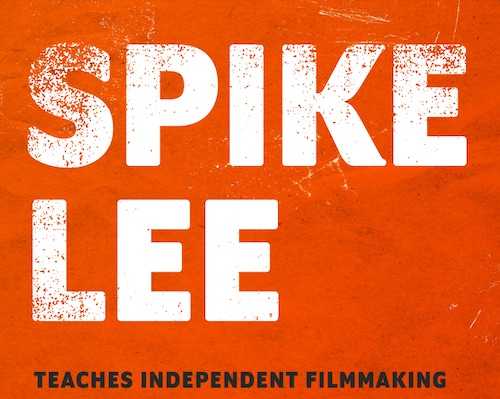
Spike Lee’s course is made up of 19 lessons, with an average of 10 minutes’ viewing time per lesson.
MasterClass has some additional resources for this course, including a Community Hub, comment section, and a 56-page Workbook.
After a short introduction in which Spike provides an overview of what you’ll learn and why it matters we move to:
Putting Words on Paper
“You have to pick the right story – the one you feel most passionate about.”
At the start of his MasterClass, Spike Lee lays down some important ground rules:
- Firstly, there is no one way to be a filmmaker
- Secondly, theory is not for him
I could tell from the offset that Spike had a very honest and direct approach to filmmaking.
This is not a class for newcomers looking to learn the rules of drama. For example, Spike doesn’t care for the 3-act structure. Instead, he insists upon the power of the story in guiding us through the filmmaking process.
In fact, Spike begins with the “idea-conception,” whereby we discover and deliberate upon the story we will tell. As Spike sees it, we need to be passionate about our ideas, as this is the spark that will carry us through to the end.
Unlike the more abstract and theoretical approaches to idea-making, he tells us exactly how he plans and organizes his notes to come up with a script. He even shows us his process from drafting to writing, and explains why he works the way he does.
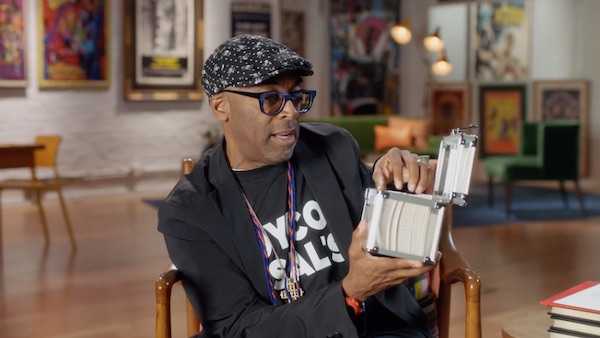
Storytelling and Camera Coverage
“I had something instinctual where I knew how to tell a story.”
Once we determine an idea, we need to learn how to best tell that story on screen. As Spike sees it, there is no key formula for doing this, and thinking as such can actually hinder us more than help us.
He teaches us how to do the following:
- Distinguish the characters within our stories
- Find stories that resonate with us and our contemporary world
- Shoot for contrast and character
- Use score to complement the story
- Separate ourselves from the characters we are presenting
While this section is focused on storytelling, Spike places most of his emphasis on how we use characters to tell our stories. For him, the actors (and their characters) are vital in portraying a narrative visually.
As he discusses, there are certain types of characters we should create in order to best tell our stories. For him, character and narrative are tightly linked, and one often informs the other. He gives us an example of this from his recent film, BlackKklansman (2018).
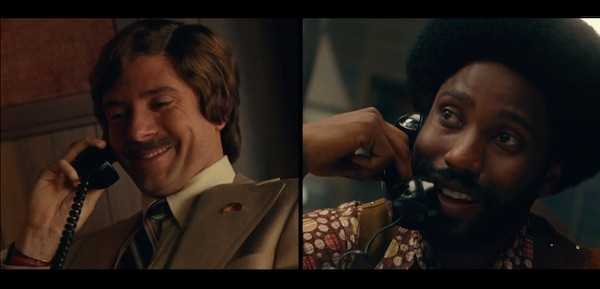
He relates to us the sense of urgency he felt in telling this story. Interestingly, the film is based on a true event from the 70s, which Spike summarises as: “a black man infiltrating the Ku Klux Klan.”
One of the struggles he encountered in telling this story was the issue of honoring both the 1970s context and the subject’s contemporary relevance.
He elaborates on how he achieved this through well-considered cinematography. He gives us some examples of the types of angles that typify his work and why he uses certain shots.
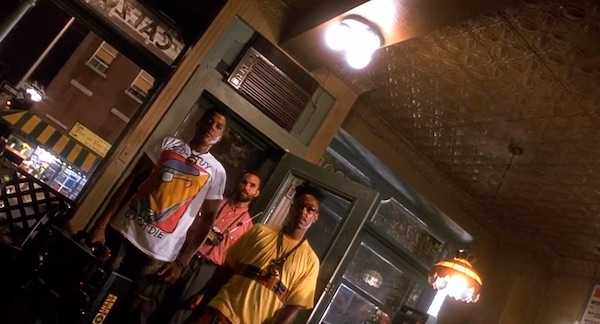
Storytelling for Documentaries
“What makes a great documentary is what makes a great feature film: the story.”
While less familiar than his feature films, Spike does dedicate a lesson to documentaries. He uses 4 Little Girls (about the 1963 Birmingham bombing) as an example of how he worked to tell a story in a different medium.
Spike provides insight into what was going through his mind in the planning process. He tells us what he did (and wanted to avoid) with such a sensitive topic and how he sought to tell an authentic story from the witnesses’ perspectives.
Spike teaches us how to:
- Approach personal interviews
- Sensitively handle upsetting subject matter
- Work with editors to make documentaries a reality
- Use other genres as activism
Speaking Truth to Power: On the Waterfront
“The way this scene is shot is almost like a resurrection.”
Drawing upon Elia Kazan’s 1954 film, On the Waterfront, Spike shows us how one of his favorite scenes works to drive storytelling and reflect the politics of the time. He gives us some context for this film to help analyze the scene, which he says works to “attack the evils of the world.”
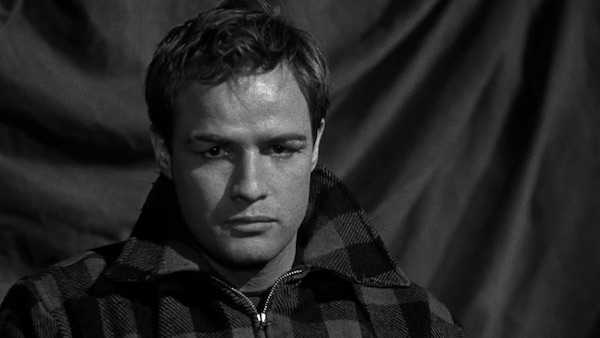
Spike compares the scene (and Marlon Brando’s character) to Colin Kaepernick in the NFL. Along with in-depth scene analysis, Spike shows us how Elia’s work compares to Kaepernick’s refusal to stand for the National Anthem.
We learn:
- The contemporary relevance of classical film
- The wider potential of film for social and political commentary
- How every choice we make in cinematography works to drive the storytelling
Spike Lee’s Film 101s
“Do the film that you could raise the money for.”
With a strict focus on independent filmmaking, Spike discusses some of the tough realities that come with funding and compromising on our movies.
Spike does a good job of exposing some of the hardships of independent filmmaking, which was something I found absent in other MasterClasses. At the same time he teaches us how to:
- Re-evaluate financial shortcomings in light of the creative opportunities they can offer
- Foster self-determination and self-reliance
- Determine a budget
- Negotiate and compromise with cast and crew when it comes to payments
I actually enjoyed Spike’s honesty in this section, as he admitted to taking shortcuts he didn’t necessarily agree with. Unlike other MasterClass I had taken, Spike’s course covers a lot of the practicalities and legal aspects of filmmaking that many young directors might not be aware of.
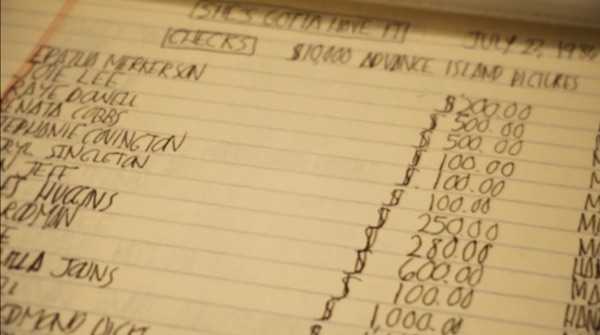
This section also considers the importance of locations, and how to best respect where you’re filming to establish a good reputation. Spike discusses why directors sometimes lose locations and what we should do when conflict arises.
Casting and Directing Actors
“I believe there are many talented people, and they need a shot.”
If characters are invaluable in telling a story, finding the right actors to portray those characters are just as crucial. This is a key takeaway from this section, as Spike discusses the need to take our time with the casting process.
Like other directors I had listened to, Spike emphasized the need for strong chemistry between actors and a determination to execute the director’s vision. Spike tells us how he auditioned Halle Berry and Rosie Perez in order to get a feel for their potential.
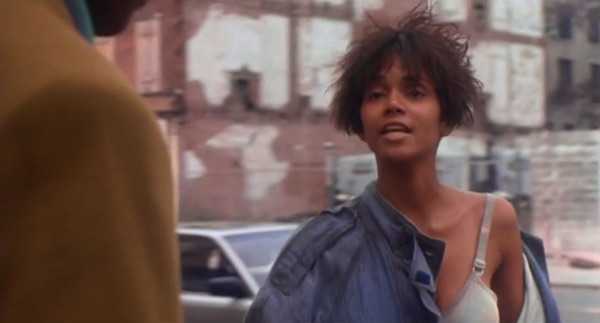
He also teaches us how to do the following:
- Seek out new talent when casting for a film
- Pitch our visions to actors
- Build strong relationships with cast and crew
- Grant actors creative input
- Cast your actors as a team
- Establish trust and respect between actor and director
This section was relatable as it considered the shyness we experience as young directors. As Spike sees it, we have 30 seconds to make a good impression when pitching to an actor. Because of this, we need a strong front and plenty of confidence when laying our visions down.
When it comes to directing actors, Spike stresses the importance of listening as much as talking. As he admits, actors can have their own ideas that work as well – if not better – than the original script. As directors, we do our cast a disservice if we do not allow actors to at least try out their ideas.
Collaborations: Actors and Director of Photography
“These hirings you make are going to be very crucial to the film.”
Similarly to casting actors, Spike believes the director of photography should also be auditioned. But we need to be judicious in the hiring process to ensure that our DP can elevate our visions.
In this chapter, Spike considers the following:
- What to consider when hiring a director of photography
- How to use budget to determine time spent on shots
- The importance of planning before shooting
- How to explain your vision to the DP
- What to prioritize during collaborations
Using Ernest Dickerson in Jungle Fever as an example of an effective DP, Spike shows us how he collaborated successfully with him to create the film. There are certain qualities Ernest possesses that are universal in successful DPs, and these are the qualities we should look for when hiring for our films.
Interestingly, Spike considers this collaboration as it unfolds on the set. As he puts it, actors come to the set ready to work, and our DP must be fast-paced and efficient to get the ball rolling. In this section, we learn a lot about pacing as well as the creative relationships that exist between directors, DPs, and actors.
As in other lessons, Spike highlights our need to be receptive to our actors. One example of this is Denzel Washington’s critique of the script for He Got Game. As Spike relates, Denzel had some significant feedback that led to Spike changing the script.
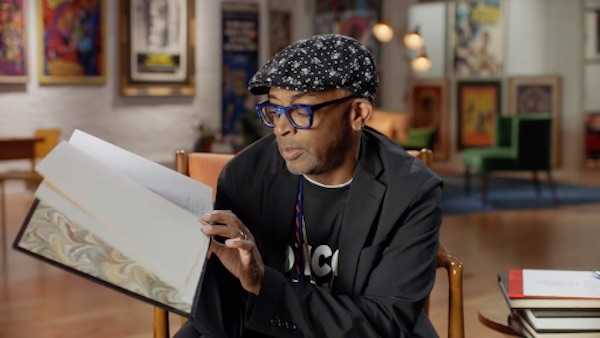
It was interesting to see how Spike received an actor’s input, despite his warnings not to act on every critique we are given. Throughout the course, Spike places a lot of focus on our need to respect actors, who, at the end of the day, are the ones portraying our vision on screen.
Opening Title Sequences
“The opening credit scene is where you have to grab your audience’s attention from the get-go.”
While I’m not overly familiar with Spike Lee’s films, I am aware of the highly stylistic title sequences that are characteristic of his work. As Spike says, the opening scenes are important for the audience as it gets them into the right “headspace” for what they are about to see.

For Spike, the opening sequences establish the tone for the rest of the film. Spike shows us a few examples in this section. These include the films, Mo’ Better Blues, 25th Hour, and BlackKklansman.
Narrating each sequence as we view it, Spike tells us how he used score, lighting, color, etc. to set up the world of the film. He takes us through his inspiration for the title sequences, and how this relates to the main story.
As a visual learner, this was a nice way to see cinematography in action and to understand the effects certain choices can have.
Music Is Key
“I understood very early on how important music can be for telling a story.”
In this section, Spike discusses the importance of a film’s composer. Like the actors and DP, the composer is a key collaborator and should be considered as carefully as any other collaborator in the movie.
Spike advocates bringing composers in early on so they can have a close involvement with the film from the early stages. He gives us some examples of his favorite collaborators – Terence Blanchard and Bruce Hornsby – and discusses why they work so well.
His focus in this section is mostly on this creative relationship, but he also delves into the following:
- Creating character themes or “sketches“
- Turning source into score
- Discussing and relating our musical visions
- The use of musical “color”
- Using music as a counterpoint
Spike gives a lot of attention to the distinctions between source and score. His key example of this is the use of music in Mo’ Better Blues, and how source and score blend together to reflect character relations.
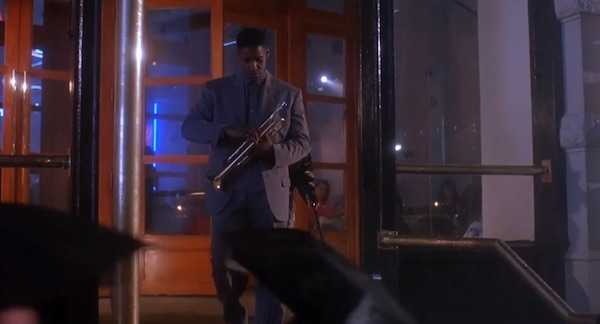
It’s clear from this lesson that Spike has a lot of respect for the power of music, and he teaches us how to reframe our thinking about it as something complementary to the visuals rather than secondary to them.
Editing
“It’s the director’s job to provide the editor with material.”
Along with music, Spike discusses editing as an essential component of post-production. He references Barry Alexander Brown as one of his key editors and stresses the importance of involving the editor in the film as early as possible.
What I found interesting in this section was that Spike didn’t see filmmaking as a linear process from script to screen. He instead emphasized our need to work on several aspects of the movie simultaneously – including editing while filming!
This differed a lot from other MasterClass I had taken, which strictly designated editing to the end-stages of the filmmaking process. As this testifies, filmmaking is without a clear set of rules, which is why it’s so interesting to hear from a range of perspectives.
Spike gives us some helpful tips for approaching editing, including what he looks out for when cutting as well as how to edit to enhance a scene’s purpose. He gives us a memorable example of this in BlackKklansman, in which he overlays multiple images during Kwame Ture’s speech on black power.

Film as an Agent of Change
“I’ve always been aware of the power of film, for good and for bad.”
In his closing sections, Spike hones his focus in on the socio-political relevance that film has for inciting change. He places emphasis on America’s creation of a “false narrative,” particularly through its denigrating portrayal of black people in movies such as Tarzan.
Something I took away from this course, and found particularly inspiring, was Spike’s mission to combat the racial myths that have been perpetuated in American movies. For those familiar with Spike’s works, this section is likely recognizable and in line with Spike’s established themes.
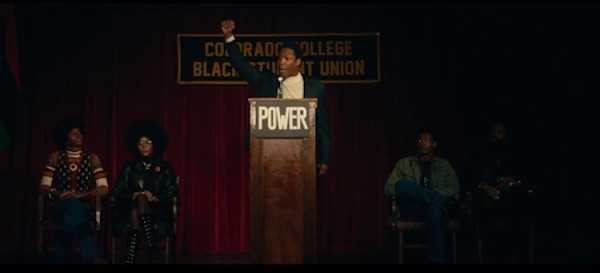
For those less familiar with Spike, it’s a fascinating insight into how films like She’s Gotta Have It broke the mold of conventional American films. In particular, his debut was groundbreaking in its portrayal of intimacy between black people – which he argues was practicality unheard of at that time.
This was a great way to see film as education as activism rather than simply as entertainment. I found this course such a strong contrast to other classes on mainstream directing. Spike’s lessons on independent filmmaking hit home for a lot of students, many of whom also wanted to redefine the landscape of cinema.
Spike leaves us with some motivating words on black people’s need to “push back the gatekeepers.” This course is by no means geared only towards filmmakers of color, but it does drive home the necessity of diversifying the world of cinema. For Spike Lee, this is particularly important for his mission to retell American history.
My Experience of Spike Lee’s MasterClass
All in all, I thoroughly enjoyed Spike Lee’s MasterClass. It gave a lot of practical insights into the realities of working as an independent filmmaker.
That being said, I don’t think this course is without its shortcomings. I hope to cover the pros and cons to help you decide whether this is the right course for you.
It’s worth noting all aspects of this review before committing to the course.
What I Liked About Spike Lee’s MasterClass
Learn from a Renowned Independent Filmmaker
In the United States, at least, Spike Lee is a household name. Having won the Academy Award for BlackKklansman in 2018, he is a well-established and revered director. Tackling issues of race, his directorial voice is commanding and hard to ignore.
This MasterClass gives you the chance to learn from one of the best American directors of our time and to go beyond mainstream cinema. Spike has a direct and honest approach to teaching, which suits the course’s concise structure.
It’s clear to see that MasterClass has carefully structured this course with Spike’s teaching style (and his students) in mind. Each video is succinct but full of content and gives us a good mixture of audio and visual learning to keep us engaged.
Strong Case Studies and Examples
One thing I liked about this course was how visual it was. It backed up Spike’s teaching with screenings and images, illustrating how cinematography looks on screen. This is helpful for remote learners who could otherwise lose engagement. It’s also great for those who learn visually and kinetically, as it allows you to take an active role in investigating a scene.
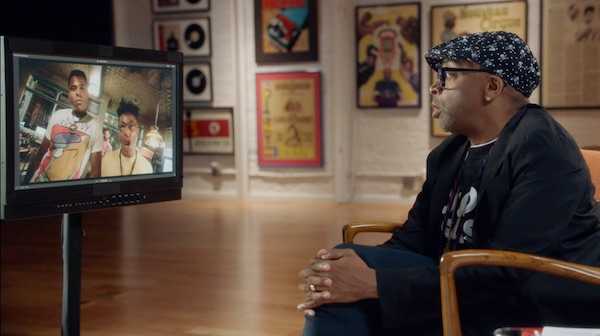
Spike’s teaching is replete with examples from his own work and classic cinema. I think this is the best way to learn when it comes to discussing a largely-visual medium such as film or TV.
Easy to Follow Teaching
As I mentioned before, Spike has a frank and honest approach to teaching. Having taught at Harvard in the 90s, he’s clearly experienced in speaking to the public and getting his ideas across.
Spike also isn’t shy when it comes to sharing his methods, and will often show us his original scripts and index cards for his movies. I found this refreshing compared to other MasterClasses, where teachers were sometimes wary of sharing too much of their craft.
In contrast, Spike takes us through step-by-step instructions of how he plans his stories and creates scenes. This is invaluable for any film student who is looking for some practical examples of where and how to begin.
Excellent Workbook
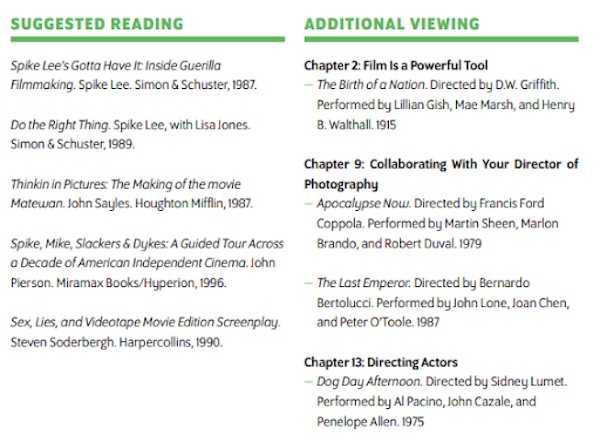
Of all of the Workbooks I’ve seen on MasterClass, Spike’s is probably the most visually-engaging and one of the most content-rich. In fact, the PDF resource goes beyond the basic chapter summaries and provides us with the following:
- A full teacher biography
- Spike’s entire filmography
- Suggested reading and viewing
- Chapter and subchapter summaries
- “Learn more” and assignments
- Trivia and appendix
Compared to some Workbooks, which are text-heavy and difficult to navigate, Spike’s has ample images and color-coordination, helping readers to stay engaged and skip to key points. It also provides further learning and assignments, so readers can take their lessons beyond the video content.
Practical Knowledge
From the offset, Spike makes it clear that this is not a theoretical course. So, if you’re looking for theory-heavy content, a course such as David Mamet’s might be more valuable to you.
Instead, Spike focuses on the practicalities of working as an independent filmmaker, covering issues of budgets, working relationships, location scouting, and casting actors. He also places a lot of focus on collaborating with cinematographers and composers.
With this in mind, Spike’s course is definitely more geared towards those with some foundational knowledge of film production. Most likely, Spike’s viewers are out of (or completing) film school, and are looking for some hands-on experience in filmmaking.
Helpful Community Hub
Along with the strong Workbook, Spike’s community hub is also a great place to explore additional learning and class discussion. Within each thread, a member of the MasterClass team prompts discussion with a subject relating to the course content.
For many, this is a great way to reinforce learning and to share ideas. Users can gain feedback on their script ideas and even debate aspects of Spike’s teaching they wouldn’t otherwise have a chance to discuss.
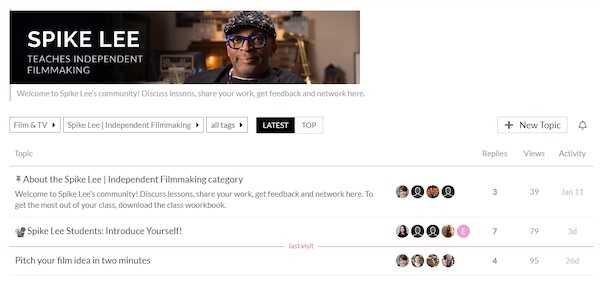
Access
Spike’s MasterClass is currently available in English with subtitles for the hard of hearing. As a relatively new resource, MasterClass is keen to expand its captions to reach a wider audience.
With that said, I’m already impressed with MasterClass’s dismissal of auto-generated subtitles. Instead, each lesson is carefully considered to ensure all text is clear and easy to follow in line with the video content.
What Could Be Improved
Confusing Course Structure
Compared to other MasterClasses, I found Spike’s to be lacking in any logical course structure. The lesson plans are disjointed and don’t seem to follow a clear trajectory. For example, there are several chapters dedicated to storytelling, but they don’t follow consecutively from the last.
At times, the course structure seems random. Spike goes from storytelling to acting, to storyboards, then back to acting again. I didn’t always understand the transition from one subject to another, and I think this is a point MasterClass should consider in future – especially when it comes to shorter courses.
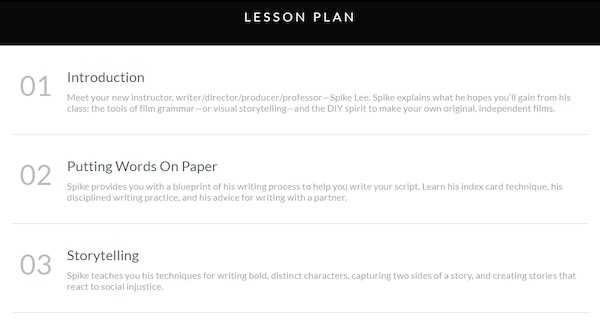
Not for Newcomers
While Spike’s lessons steer away from complicated jargon, this course is not really suited to newcomers. In fact, it assumes some basic film knowledge on behalf of the viewer, and doesn’t cover the specifics of camera use, terminology, or any physical demonstrations.
Spike’s entryway into the class is a step-by-step guide to finding an idea, planning a script, and finding the right cast and crew to bring your vision to life. I got the impression that this course was more geared towards students in film school looking to create their first feature film.
Less Theory-Based
As I mentioned before, Spike is unquestionably dismissive of film theory. He doesn’t even consider the 3-act structure, and insists upon the restrictiveness of any formula.
In fact, as a filmmaker eager to disrupt the mainstream conventions of cinema, Spike seems to advocate experimentation over following the rules. As he flippantly comments, “There’s so many rules. Who made up that rule?”
Focus on Socio-Political Filmmaking
Anyone familiar with Spike Lee will know his ambitions to portray unspoken racial tensions and to also bring diversity to the big screen. While only a couple of chapters are explicitly focused on film as activism, it’s worth noting this is an important part of Spike’s filmmaking.
If you’re looking for more lighthearted and “strictly entertainment” lessons in filmmaking, another course might be more suitable. It’s understandable that Spike is keen to share his “mission” with his viewers and to advocate for what he believes in when it comes to diversity and inclusion.
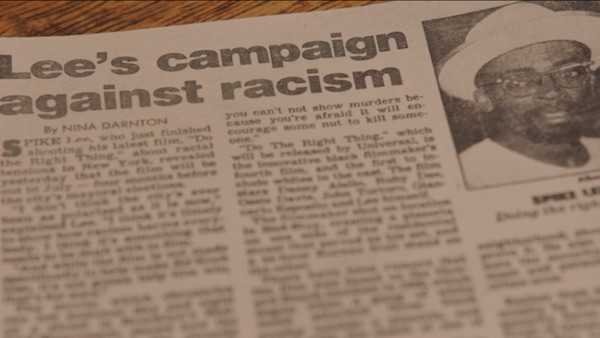
Many of Spike’s case studies focus on race relations and how to use film as a tool for retelling history. I’d go as far as to say this underpins most of his lessons, and it’s worth bearing this in mind when considering the course.
Less Suited to Non-Independent Filmmaking
It’s probably clear by now that Spike steers away from mainstream Hollywood movies in favor of portraying the unspoken realities of race relations in America. This is definitely not the only defining feature of Spike’s films, but I think it’s significant to note when deciding what type of filmmaking you’re eager to learn about.
If you’re interested in more recognizably “Hollywood” films, a course such as Ron Howard’s might be more suitable.
Who Is This Course For?
On a scale of 1-10 (1 being a beginner and 10 being an expert), I’d say this course is geared towards those between 3 and 10. Spike does cover a lot of basics, including how to plan a script and write a screenplay.
That being said, it also assumes a lot of prior knowledge when it comes to understanding cinematography, music and lighting. I’d say this course targets film school students and graduates who have some basic experience in film and are looking to launch their careers.
As the MasterClass states, this course teaches independent filmmaking. With this in mind, you can expect to learn a lot about juggling various roles on your own, financing, and negotiating with your team members.
In this course, you can expect to learn how to do the following:
- Build a trusting relationship with cast and crew
- Plan budgets and funding for your film
- Cast the right actors for your film and budget
- Create valuable connections within the industry
- Listen to and evaluate criticism
- Find the right collaborators for your movie
How much does the course cost?
All-Access Pass
The all-access pass is a yearly subscription costing $120. This allows you to access an unlimited number of courses throughout the year. You can mix and match any subject and dip in and out whenever you’d like.
If you’re interested in a particular topic, I think this is great value for money. With filmmaking, you can take courses from several experts and cover a range of specialities.
MasterClass also has a gift option.
And it’s worth remembering that MasterClass provides refunds within 30 days if needed.
Alternatives to Spike Lee’s MasterClass
Aside from Spike’s MasterClass, the following filmmaking courses are available:
- Jodie Foster Teaches Filmmaking
- Werner Herzog Teaches Filmmaking
- Ron Howard Teaches Directing
- Martin Scorsese Teaches Filmmaking
- Mira Nair Teaches Independent Filmmaking
- Ken Burns Teaches Documentary Filmmaking
- Aaron Sorkin Teaches Screenwriting
- David Lynch Teaches Creativity and Film
Outside of MasterClass, I found a filmmaking course on Udemy. This isn’t specifically geared towards independent filmmaking, but it was probably the most similar course I could find. The New York Film Academy also has some online workshops that are date-specific.
In addition to that there are specialist film making platforms such as MZed that offer a range of high quality courses for all abilities. Find out more in our MZed review.
With the exception of some of the classes available on MZed, most alternatives don't compare with the level of teaching and production values found on MasterClass.
Spike Lee’s MasterClass: What Others Have Said
While researching feedback for this course, I found an overwhelmingly positive response. As one user noted, this class exceeded their expectations and even taught them more practical lessons than they got from college.
"I just completed this class and it was just amazing. The class is everything I could have hoped for and more on filmmaking from an accomplished artist and master filmmaker. I spent three years studying for a degree in the nineties which culminated in a lot of debt, so I wouldn’t recommend studying creative subjects from ‘educators’ who have no experience in doing it for real in a professional context. Anyone who wants to understand filmmaking and its realities, especially for those who realise its importance as a medium and which to put across a passionate message, should take Spike Lee’s class. Money cannot put a price on the quality of knowledge imparted by Spike Lee here, cue applause." - Comment from the community
This commenter makes an interesting point about lectures vs. practical experience. While I believe film school has its values, I don’t think such theory-based learning can compare to what we get from Spike. If you’re looking for practical teaching, I think Spike’s course is possibly unbeatable.
I often use Reddit to get honest feedback about different MasterClasses. Most users who had taken the course agreed that it was worth the money. However, others were sceptical about how much an online course could include.
"I like some of Spike’s films but this sounds like you are paying for a podcast." - Comment from Reddit
It’s true that Spike’s course is mostly focused on his own opinions and case studies, and the class lacks the physical demonstrations we get from other directors. Overall, most users on Reddit were pleased with Spike’s class, and cited it as one of the better film courses on the website.
"I also got a subscription for xmas tis year. I’ve made it through Spike Lee and Werner Herzog (both great). I agree that buying the full access is the way to go." - Comment from Reddit
Is the course content unique?
When looking into Spike’s previous advice on filmmaking, I found a few interviews where he discussed financing independent movies. Aside from this, I couldn’t find any in-depth discussions that covered the same scope as his MasterClass.
As he tells us at the end of the course, he wanted to do the MasterClass so he could share his process and love for cinema. As his only online course, this suggests to me that this content is unique. Even fans who were aware of his previous interviews attested that this would be a great opportunity to learn more from their favorite director.
"I can’t wait to get this! Do the Right Thing is one of my favorite movies! Can’t wait!" - Comment from the community
What You Will Need
This course doesn’t require any equipment or tools in order to complete it. However, if you learn best by annotating and writing, a notepad and pen (and a printer!) are useful. The Workbook has a lot of suggested reading and viewing, so a library or film site subscription could be useful.
Is Spike Lee’s MasterClass worth it?
If you’re interested in creating independent films, I’d say this course is definitely worth it. Spike’s lessons are heavily focused on funding your film and “getting out there.”
He covers a lot of content on collaboration, creating title sequences, and editing your movie. Because of this, it’s less suited to those who are interested in learning theory or analysis alone.
Pros:
- Learn from a renowned filmmaker
- Strong case studies and examples
- Easy-to-follow teaching
Cons:
- Not a course for beginners
- Focus on socio-political filmmaking
- Less theory-based than other courses
In this MasterClass, you will learn how to:
- Find and develop compelling film ideas
- Write a screenplay and shot list
- Finance your films and build your team
- Use imagery and music to tell a story
- Make the most of your time in the editing room
- Use film as a tool for activism and change
The $120 all-access pass is good value for money if you’re open to other types of film courses. This includes directing, screenwriting, and even creativity.
Spike’s course definitely excels in teaching film as a tool for socio-political commentary and activism. It’s created with independent filmmaking in mind, and you can expect to learn the specifics of funding and advancing your project to the final cut.
Spike’s MasterClass in Independent Filmmaking is a worthwhile investment for anyone looking to get their foot in their door. As Spike himself says, “grab a camera and get out there.”
Frequently Asked Questions
The all access pass allows you to take this class, along with up to 200 others for $10 a month billed annually.
There are 19 lessons totalling just over 3 hours.
There is no way to access Spike’s MasterClass for free. This closest option to this is if someone buys it for you.
MasterClass have a 30 day refund policy if you purchase from them. If you purchase from another supplier, their own returns policy may apply.

Rebecca graduated from King's College university with a first class honours in English Language, followed by a Masters' Degree in Eighteenth Century Studies.

Salve, la masterclass di Spike Lee lascia un qualche attestato una volta finito?
Hi Laura,
Thanks for you comment 🙂
You don’t get a certificate for completing the Spike Lee MasterClass (in fact, no MasterClass classes come with certificates). But you do get the knowledge and best practices from the instructors.
That is the suitable blog for anyone who needs to seek out out about this topic. You notice so much its almost exhausting to argue with you (not that I truly would need…HaHa). You undoubtedly put a new spin on a subject thats been written about for years. Great stuff, simply nice!
Thank you so much! 😊 We’re thrilled to hear that you found the blog insightful and engaging. It’s always great to bring a fresh perspective to important topics. We truly appreciate your support—stay tuned for more great content!